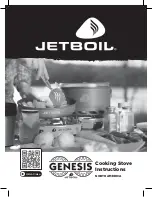
30
A little more about wood
Use dry wood with moisture content of less than 17%. This means that the wood has dried for about 1-2 years.
Wood should be cut in 10 to 12 inch lengths.
Do not use unseasoned wood. Raw wood gives little heat because much of the energy is used to evaporate the
water. It gives a lot of smoke and soot coating on the internal surfaces of the stove and in the chimney. The
water vapor that condenses in the stove can leak out between the stones, causing black spots on the stone and
floor. If the soapstone gets such soot stains, they can be removed with the help of soap and cloth, or possibly
fine sandpaper (180). The water vapor can also condense in the chimney to form creosote. Creosote is highly
flammable and can cause soot fire.
Firing
Your masonry heater does not need to be, and should
not be, fired constantly to provide an even heat. Firing
with several hours intervals is optimal for these type
of stoves. Because of the heat retaining characteristics
you will experience an even heat output when firing
3-4 times a day. We recommend using about 4 lbs (2
kg) of wood for one firing, and never more than 6 lbs
(3 kg). In this way your stove will provide a heat output
during the whole day and night of about 1-3 kW when
firing 3 or 4 times a day. If you need more or less heat
you can shorten or lengthen your firing intervals.
Make sure you have a good draft in your chimney.
In the beginning of the firing cycle you should have
full draft. This can be reduced a bit after the first five
minutes. Never close the draft during the firing, since
this will lead to a very inefficient combustion and
release of particles in the air. After the fire has been
extinguished, close the draft completely to make sure
you do not vent the stove from the inside, losing the
accumulated heat through the chimney. Your stove,
depending on the size and how hard it has been fired,
will keep you warm for 6 to 12 hours.
You should only fire with dry firewood with maximum
moisture content of 20%, this is a prerequisite for
the well functioning of your stove. Make sure your
firewood is also cut in sufficiently small pieces. We
recommend pieces of not more than one lb. each. The
best results will be when firing from the top, with small
pieces of wood lying on top of the wood-stack as the
picture below shows.
For further information see also our homepage www.
norskkleber.com
The adjustment of the air into the burn chamber is
done with the lever at the bottom of the door. When
the lever is completely out you have maximum air
supply. As long as you have fire the lever should
never be less than half-way out to avoid incomplete
burning of the wood.
Starting and maintaining a fire:
1. With primary air control lever in the full open
position, place two short 1/4-split logs on the
firebox floor, perpendicular to the rear wall,
about 6 inches apart.
2. Place kindling across the base logs.
3. Place one or two smaller logs on top of the
kindling.
4. Place newspaper between the two bottom logs
under the kindling. Light the newspaper and
close the door. Continue to add kindling and
small logs as necessary to build the fire. Keep
the air control fully open until the fire is well-
established.
Example of a
wood stack
and how to
light it.
Summary of Contents for Kube 3
Page 17: ...Exploded view ...
Page 28: ...Exploded Parts View ...






































